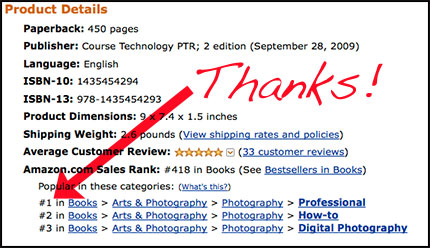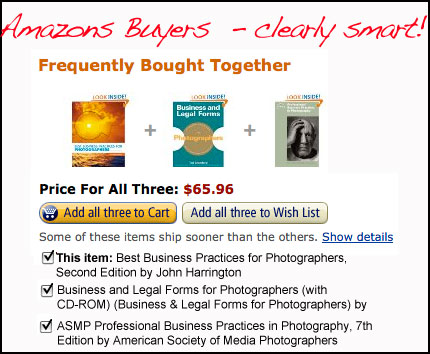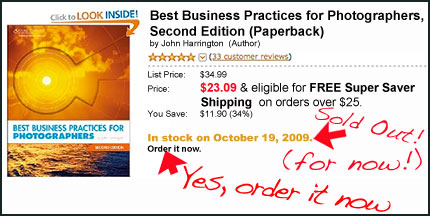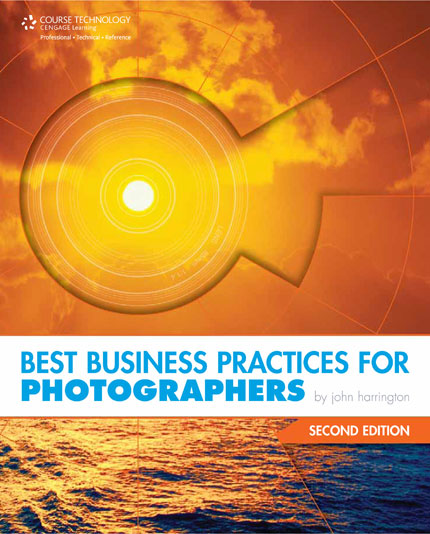As to sheer volume, the previous book was 352 pages, and this one weighs in at over 500 pages, and jumps from 26 chapters to 32 chapters. That said, a quality book does not survive on volume alone. What's actually been added/updated?
|
"Harrington’s book is a must-read -- a valuable resource for photographers of all levels and specialties."
~ Jeff Sedlik, Former President, Advertising Photographers of America
|
|
"This is the book every photographer needs. It reveals the terrible truth that taking the photograph is the easy part; dealing with business and legal issues make the difference between success and failure. This encyclopedic book is a vital reference I wish I had starting out 30 years ago."
~ Art Wolfe, photographer
|
|
Chapter 2: Transitioning to Freelance
In BBP1, this subject was addressed in just over a single page. Because of the significant changes that so many staff photographers have been subjected to, this subject spans an entire chapter. Of the utmost importance here, for you current staffers and non-staffers is information on how to assist the new-found freelancer entering into the community in a positive way.
|
Chapter 5: Working with Reps, Assistants, Employees, and Contractors: The Pitfalls and Benefits
In BBP1, the subject of working with others was just about assistants and contractors. In BBP2, we expand the chapter to include working with talent that will help you shape your marketing efforts, handle your negotiations, prepare your bids/estimates, and otherwise make your life easier all around. If you've ever said "I want a rep, how do I get one"; or "I have no idea how to prepare this estimate and handle the negotiations, nor do I ever want to", this chapter will be of great insight to you.
|
"I have given many talks at universities across America to students studying photography. I'm often asked the question 'what's the most important thing a photographer can do to prepare for this life' and I always say 'learn to run a small business.' John Harrington's book is that curriculum. You don't have to go to college. You don't have to major in small business administration, but you do have to read John Harrington's book. This is the bible of running a successful photography business."
~ Sam Abell, Photographer
|
|
John Harrington’s revised edition of his Best Business Practices for Photographers goes beyond a few timely updates. Using his own business experiences John has adjusted his business practices to the changing photography industry. Addressing topics such as “Pricing your work to stay in business”, the first hand – “Insights into am IRS audit”, and the timely “transitioning to Freelance”, for the newspaper staffers entering the self-employed business world. This book delivers the business information many of us have learned at the "school of hard knocks" and most photo schools don’t even offer, but with this book readers can learn how to build a successful career."
~ Richard Kelly, Photographer, Educator & President ASMP
|
|
Chapter 6: Setting Your Photographer’s Fees
In BBP1, Chapter 5 was devoted to "Pricing Your Work To Stay in Business", but that just wasn't enough. While that chapter remains, and can be seen more as an overview now, Chapter 6 helps you through the process of setting your own fees - fees that are right for you and your community. Yes, some numbers are presented, however since the cost of doing business in a small town in Iowa isn't the same as New York City, these are tools to help you determine your own best figures.
|
Chapter 10: Insurance: Why It's Not Just Health-Related, and How Your Should Protect Yourself
In BBP1, We talked about health, life, disability, and business insurance. BBP2 includes explanations about errors and omissions insurance and umbrella policies.
|
"Pricing, contracts, copyright -- even IRS audits: If you are going to walk through the minefield that is the business of being a professional photographer, you'll want a good map. And 'Best Business Practices...' is exactly that."
~ David Hobby, Strobist.com
|
|
"It is no longer enough to be a creative photographer. The tough part is navigating through business deals and complicated contracts. John Harrington’s book will help readers to run a business as the age of the digital technologies reshapes the craft of photography at every level. The book is a virtual knowledge bank and will help readers think cleverly as they negotiate this highly competitive arena."
~ Ami Vitale, Photographer
|
|
Chapter 12: Insights into an IRS Audit
Sadly, my suffering is fodder for not just your entertainment, but also insights that might make your own audit experience less painful than mine. Though this chapter, you'll learn about some of the pitfalls I fortunately avoided, so that if you ever do get audited, you'll be the one being owed money (as I was).
|
Chapter 18: The Realities of an Infringement: Copyrights and Federal Court
As the ideas and plans or BBP1 were underway, one of the case studies I wanted to include was about how to send an official notice to get someone who is infringing your images taken down from a website. It slipped through the cracks, and I couldn't sneak it in at the last minute (I tried.) In BBP2, step by step, you'll see how to send that takedown notice (known as a DMCA takedown notice) and realize that it's actually easier than you thought.
|
"'Best Business Practices for Photographers' is not exactly a catchy title, but if you are starting as a professional shooter, or have been in the biz like me for over four decades, you better put down your camera and buy this book. I predict it will make your business better and more productive. When it does, drop me a line at: (get the link from his website) and give me one example of how it changed your life."
~ David Hume Kennerly, Pulitzer Prize Winner
|
|
"When I was in photo school I often asked for resources on how to run a photo business. Wish this book was available to me then. This is the best, one source for understanding the business of photography. From basic principles of bookkeeping to the open ended practice of pricing, this book provides many answers. For me the best updated information in John Harrington’s new edition of “Best Business Practices for Photographers” is in the area of licensing and how licensing needs to be a part of your fee structure. The inclusion of PLUS, Picture Licensing Universal System, in your business and licensing models is the best advice John has for the professional photographer. It will provide improved management of your licensed images well into the future. John truly contributes to the APA Mission of Successful Photographers."
~ Stephen Best, CEO, Advertising Photographers of America
|
|
Chapter 19: Releases: Model, Property, and Others
Search the index of BBP1 and the words "Model Release", or even "releases" don't appear. Last time around, I was so focused on the rest of the really important issues, that this one just slipped past me. This time, all different types of releases are discussed, including issues like trademarks and logos that appear in your photographs, that you thought you didn't have to worry about. (Hint: you do.) We even include a case study of one photographer who was sued because of the issues of releases when the subject was less than happy about how the photograph he signed a release for was used.
|
Chapter 26: Licensing Your Work
Just as with the addition of Chapter 6, the subject of this chapter was just a few pages in BBP1 Chapter 5, as a "licensing primer". Now, we've devoted over 40 pages to the very important issue of licensing, including tools to make licensing easier, more clear, and more concise. Software examples are shown that write licenses for you (free or for cheap), and even the wedding or family portrait photographer can benefit from clear "personal use" licenses, so clients don't think they can do whatever they want with the images (like sell their images as stock or make multiple prints at the local photo lab.)
|
"This book is a must-have for EVERY photographer, amateur or pro, who wants to maximize income with photography. Harrington breaks down the mystery of pricing, negotiation, contracts and client relationships with real-life examples and provides an excellent template for a stable-growth business method. Also, one of the most important and often neglected aspects of photography, COPYRIGHT REGISTRATION, is addressed in depth including the new eCO electronic filing system. The first edition of this book has been a go-to reference for me for the past few years and this expanded and updated version will be in my office as soon as it is published. There is no doubt that Best Business Practices for Photographers will pay for itself thousands-fold."
~ Chris Usher, Photographer
|
|
"John Harrington has added so much information in his second edition that is relevant to the business climate of photography today. The new edition will be especially helpful to photojournalists who need to be prepared for the future in a changing profession. This needs to be on the bookshelf of every student and photographer."
~ Dr. Bob Carey, President, National Press Photographers Association
|
|
Chapter 27: Stock Solutions: Charting Your Own Course without the Need for a “Big Fish” Agency
The field of solutions has narrowed since BBP1, and we've expanded on our thoughts since that edition. Further, BBP2 readers have a special offer from one of the solutions that is a part of this chapter.
|
Chapter 31: Expanding Into Other Areas of Creativity
In BB1 we didn't discuss the possibility that you would be expanding your creative offerings to include video or working on a book deal. Yet, many photographers are finding these profitable ancillary avenues of both revenue and client service. As such, we've included discussions and suggestions on these topics in their own chapter.
|
"From my perspective of 40-plus years in photography -- as shooter, picture editor and director of photography -- "Best Business Practices..." is fantastic. This book provides great insights into the business of photography, and much more. With the photography business in a state of flux, 'Best Business Practices...' should be at the top of every photographer's reading list."
~ Kent Kobersteen, former Director of Photography, National Geographic Magazine.
|
|
"John's book is a necessity for every professional photographer! It could well be one of the greatest business resources available, helping you get through unfamiliar challenges from IRS Audits, licensing your work to developing a relationship with your rep and more. Most photographers are creative and right brain driven - here's the food your left brain forgot to tell you about!"
~ Skip Cohen, President, Marketing Essentials International
|
|
I am extremely excited about the extensive addition on matters like licensing your work, and establishing your fees. In addition, with the economy the way it is right now, and has been for some time, the chapter on transitioning to freelance is essential not just for the new-found freelancer, but also a good prep for the current staffer, so they are prepared in case things change for them. |






